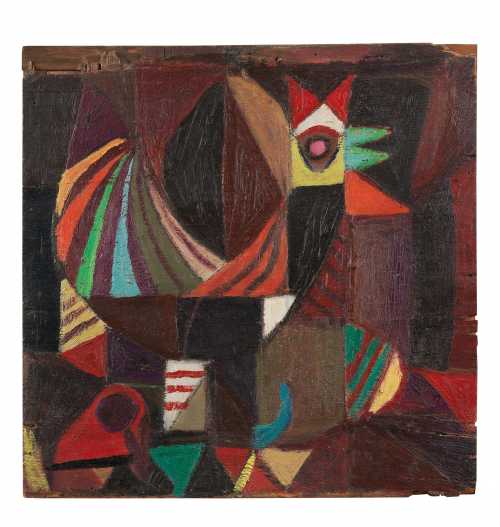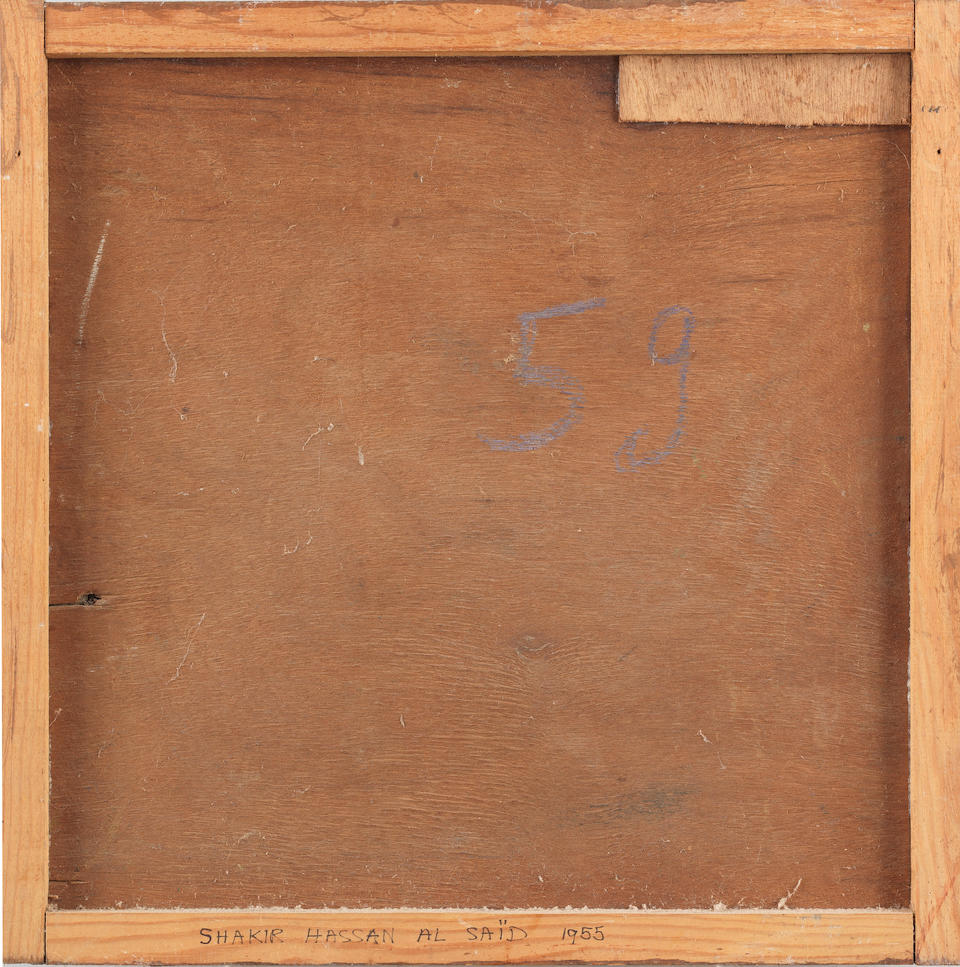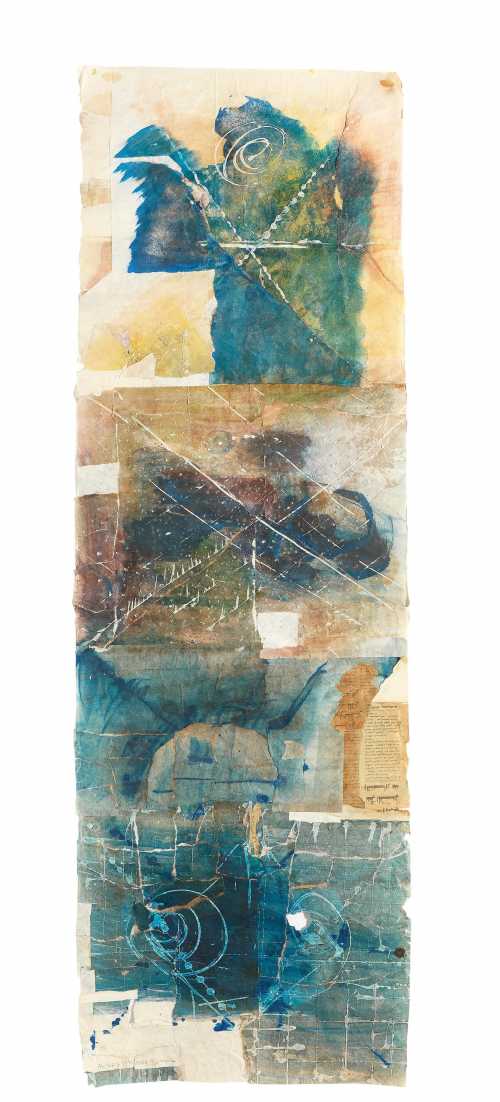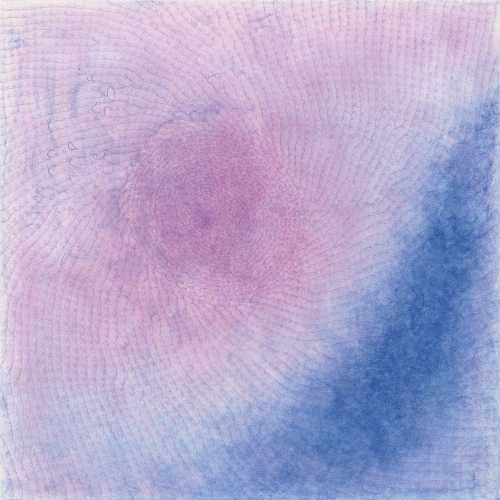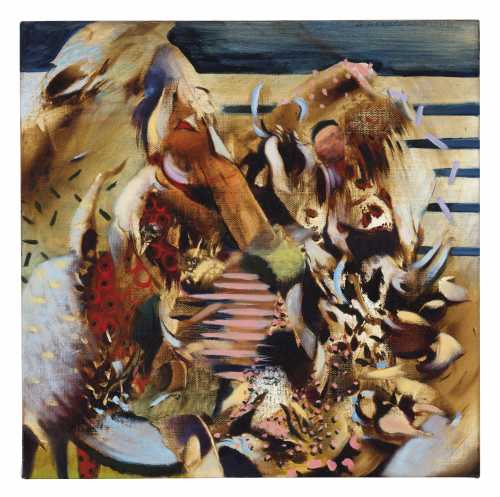- Cubist Cockerel 1955
- Oil on board
- Painting
- 40.5 * 40 cm
- Signed "Shakir Hassan Al Said" and dated "1955" on the verso, executed in 1955
Framed
17 November 2021
Estimation
£30,000
41,351 USD
-
£50,000
68,918 USD
Realized Price
£67,750
93,384 USD
69.375%
Artwork Description
AN IMPORTANT SHAKIR HASSAN AL SAID FROM THE SELIM FAMILY COLLECTION, GIFTED DIRECTLY BY THE ARTIST TO JEWAD SELIM IN 1955
"We wanted to clarify to Iraqi artists in general, and to ourselves as an art group in particular, that istilham alturath (seeking inspiration from tradition) is the basic point of departure to achieve a cultural vision through modern styles."
- Shakir Hassan Al Said
Provenance:
Property from the collection of Jewad Selim
Gifted to the above by Shakir Hassan Al-Said, circa 1955
thence by descent
1951 marked the point when Iraq's two most prominent artists, Jewad Selim and his student Shakir Hassan Al-Said, formed the countries first bona fide modern art movement; The Baghdad Group of Modern Art, through its manifesto, membership, and numerous exhibitions would come to signify a "golden age" in Iraqi modernism.
Shakir Hassan Al-Said is often regarded as the theoretical dynamo of the movement; more vocal and prolific in his written output than Selim, Jabra Ibrahim Jabra comments that "no Iraqi artist has written about art in general, and about the artists reflections on his own work in particular, as much as Shaker Hassan Al Said".
The Baghdad group was defined by an attempt to reconcile the grand visual legacy of the past within the contemporary cultural and nationalistic narrative of twentieth century Iraq. Mesopotamian iconography and Islamo-Arabic cultural motifs were combined with popular modern folk imagery; the high flown formal rigidity of ancient rock reliefs met the convoluted urban landscape of modern Baghdad, populated with the humorous and extravagant characters of daily life, all coming together to form a unique amalgamated aesthetic that reflected the evolving patchwork of Iraqi culture at the time.
Light hearted and boisterous, Al Said and Selim's depictions revelled in the rich and florid aesthetic of the Baghdad Street. The present work, a depiction of a Cubist Cockerel, is a quintessential example of this. A recurring motif in Arab culture, the cockerel has been a subject of ancient pottery, metalwork and embroidery. Seen as a traditional symbol of sustenance, nourishment and rural plenty, it is even said in the hadith of Abu Dawud that the Prophet Muhammad told his followers "not to revile the rooster for it wakes you up for prayer".
Appropriating a symbol that is not only literally recurrent within the urban scenery, but signals the coming of the day, the passage of prayer, and which satisfies an important mercantile function, exemplifies the aim of the Baghdad Group's agenda, which was to depict an art which engaged the people, and which was reflective of their collective experience.
In using a rich and uplifting Expressionist palette, and the visual language of the cubists, Al-Said's rooster assumes qualities and characteristics above and beyond the mere representational; by stressing vibrant colours and an angular anatomy, an abstract structure is favoured at the expense of strictly pictorial elements, an effect that is heightened as visual elements of the background fauna correspond to the representation of the Cockerel in palette and contour. The ultimate effect is that of the Cockerel as purely symbolic and highly stylized, an artistic invention.
Acquired from Shakir Hassan by Jewad Selim, it is hard to think of a work with better provenance or one that closer to the very heart of the Baghdad movement than the present work. Given by student to teacher, cherished by him and his family for close to half a century, Al Said's Cubist Cockerel can truly be described as "best of breed".
"We wanted to clarify to Iraqi artists in general, and to ourselves as an art group in particular, that istilham alturath (seeking inspiration from tradition) is the basic point of departure to achieve a cultural vision through modern styles."
- Shakir Hassan Al Said
Provenance:
Property from the collection of Jewad Selim
Gifted to the above by Shakir Hassan Al-Said, circa 1955
thence by descent
1951 marked the point when Iraq's two most prominent artists, Jewad Selim and his student Shakir Hassan Al-Said, formed the countries first bona fide modern art movement; The Baghdad Group of Modern Art, through its manifesto, membership, and numerous exhibitions would come to signify a "golden age" in Iraqi modernism.
Shakir Hassan Al-Said is often regarded as the theoretical dynamo of the movement; more vocal and prolific in his written output than Selim, Jabra Ibrahim Jabra comments that "no Iraqi artist has written about art in general, and about the artists reflections on his own work in particular, as much as Shaker Hassan Al Said".
The Baghdad group was defined by an attempt to reconcile the grand visual legacy of the past within the contemporary cultural and nationalistic narrative of twentieth century Iraq. Mesopotamian iconography and Islamo-Arabic cultural motifs were combined with popular modern folk imagery; the high flown formal rigidity of ancient rock reliefs met the convoluted urban landscape of modern Baghdad, populated with the humorous and extravagant characters of daily life, all coming together to form a unique amalgamated aesthetic that reflected the evolving patchwork of Iraqi culture at the time.
Light hearted and boisterous, Al Said and Selim's depictions revelled in the rich and florid aesthetic of the Baghdad Street. The present work, a depiction of a Cubist Cockerel, is a quintessential example of this. A recurring motif in Arab culture, the cockerel has been a subject of ancient pottery, metalwork and embroidery. Seen as a traditional symbol of sustenance, nourishment and rural plenty, it is even said in the hadith of Abu Dawud that the Prophet Muhammad told his followers "not to revile the rooster for it wakes you up for prayer".
Appropriating a symbol that is not only literally recurrent within the urban scenery, but signals the coming of the day, the passage of prayer, and which satisfies an important mercantile function, exemplifies the aim of the Baghdad Group's agenda, which was to depict an art which engaged the people, and which was reflective of their collective experience.
In using a rich and uplifting Expressionist palette, and the visual language of the cubists, Al-Said's rooster assumes qualities and characteristics above and beyond the mere representational; by stressing vibrant colours and an angular anatomy, an abstract structure is favoured at the expense of strictly pictorial elements, an effect that is heightened as visual elements of the background fauna correspond to the representation of the Cockerel in palette and contour. The ultimate effect is that of the Cockerel as purely symbolic and highly stylized, an artistic invention.
Acquired from Shakir Hassan by Jewad Selim, it is hard to think of a work with better provenance or one that closer to the very heart of the Baghdad movement than the present work. Given by student to teacher, cherished by him and his family for close to half a century, Al Said's Cubist Cockerel can truly be described as "best of breed".
More lots by Shakir Hassan Al Said
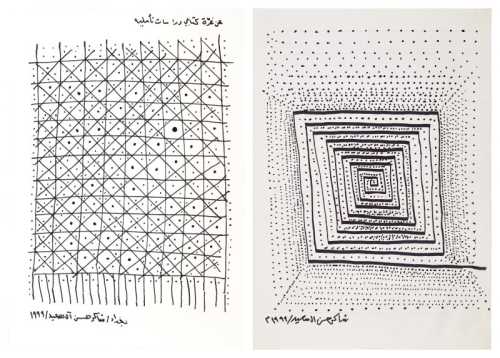
i) About my book: Contemplative Studies ii) Untitled
Estimation
£8,000
9,942 USD
-
£12,000
14,912 USD
Realized Price
£21,590
26,830 USD
115.9%
Sell at
Sale Date
Sotheby's
-
27 April 2023
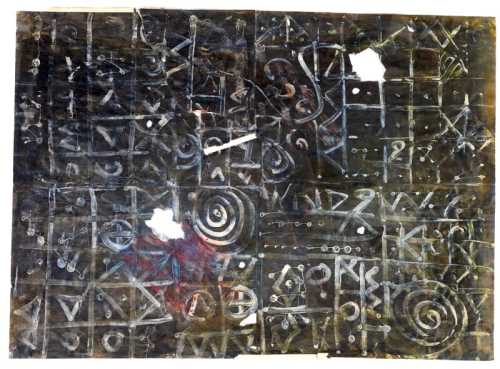
Untitled (Talismanic Rectangles)
Estimation
£7,000
8,699 USD
-
£11,000
13,670 USD
Realized Price
£8,890
11,048 USD
1.222%
Sell at
Sale Date
Sotheby's
-
27 April 2023
Realized Price
60,995 USD
Min Estimate
37,759 USD
Max Estimate
58,489 USD
Average Artwork Worth
+25.459%
Average Growth of Artwork Worth
Sales Performance Against Estimates
Average & Median Sold Lot Value
2021 - 2025
Performance vs. Estimate
2021 - 2025
Sell-through Rate
2021 - 2025
Similar Artworks
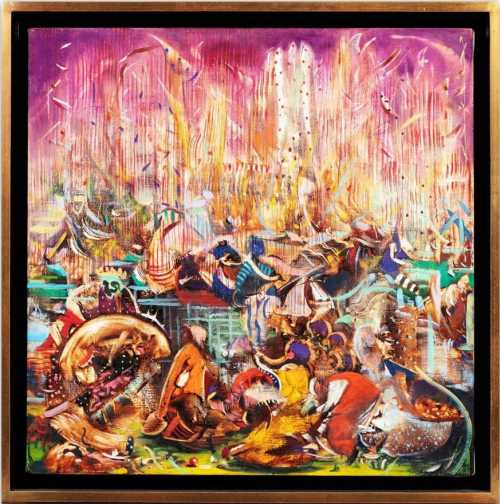
The Sun - Son
Estimation
€60,000
69,686 USD
-
€80,000
92,915 USD
Realized Price
€94,500
109,756 USD
35%
Sell at
Sale Date
Sotheby's
-
19 October 2021
